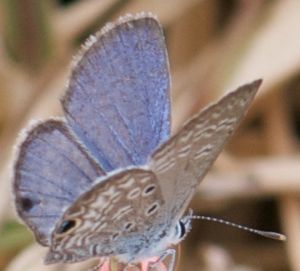On March 19, 2012 on a warm day with calm breezes, after a weekend of similar weather, the first butterfly spotted on the trail transect B was a Northern Cloudywing (Thorybes pylades) sitting on the ground and so well camouflaged against the brown leaves. This species is in the Skipper Family (Hesperiidae).
The hammock was full of fluttering Viola's Wood-Satyrs, Megisto viola. This is typical for April, but March is early for them. This butterfly is in the Brush-foot Family (Nymphalidae). Adults have a slow bouncing flight and will rise as far as the tops of tall trees. Males patrol in the shade to find females. Eggs are laid singly on grass blades, which the caterpillars eat. Adults nectar on wood sap, rarely flower nectar. We counted 88 of this species in our transects, but there were hundreds more along the trails outside the boundaries of our transects.
We discussed other "bugs" along the way.
Did you know: A bee is an herbivore, a wasp is a carnivore.
We saw two Eastern Pygmy Blues (Brephidium pseudofeain) in the glasswort (salicornia) transect C. This is their preferred habitat, near saltwater in coastal marshes and tidal flats, and the glasswort is a host plant. Our transect is not soaking wet this year, as it was last year. We did not count any of the species last year. Today they were observed resting with their wings closed on the glasswort, tiny and looking brown in color, but when they open their wings the blue highlights are visible. Males patrol low over the host plants in search of females. Flight is weak and slow. Adults nectar on palmetto palm and saltwort (Batis maritima) flowers. This species is of the Blues and Hairstreaks Family (Lycaenidae).
We also counted salt marsh skippers in this transect. Skipper Family (Hesperiidae).
This species is more commonly seen in Transect A at the water's edge.
In transect D, the Red Bay transect, we again observed many Viola's Wood Satyrs.
We also counted more than 20 Palamedes (Papilio palamedes) in transects B and D. This butterfly is in the Swallowtail Family (Papilionidae). They nectar on the thistle which was plentiful today, especially in Transect B.
We also saw a resurgence of Red Bay (Persea borbonia) saplings; this species of tree is a host plant for the Palamedes. We have wathced the red bay trees dying in this transect over the last few years, due to the fungus left by the invasive ambrosia beetle.






.png)








.png)





















